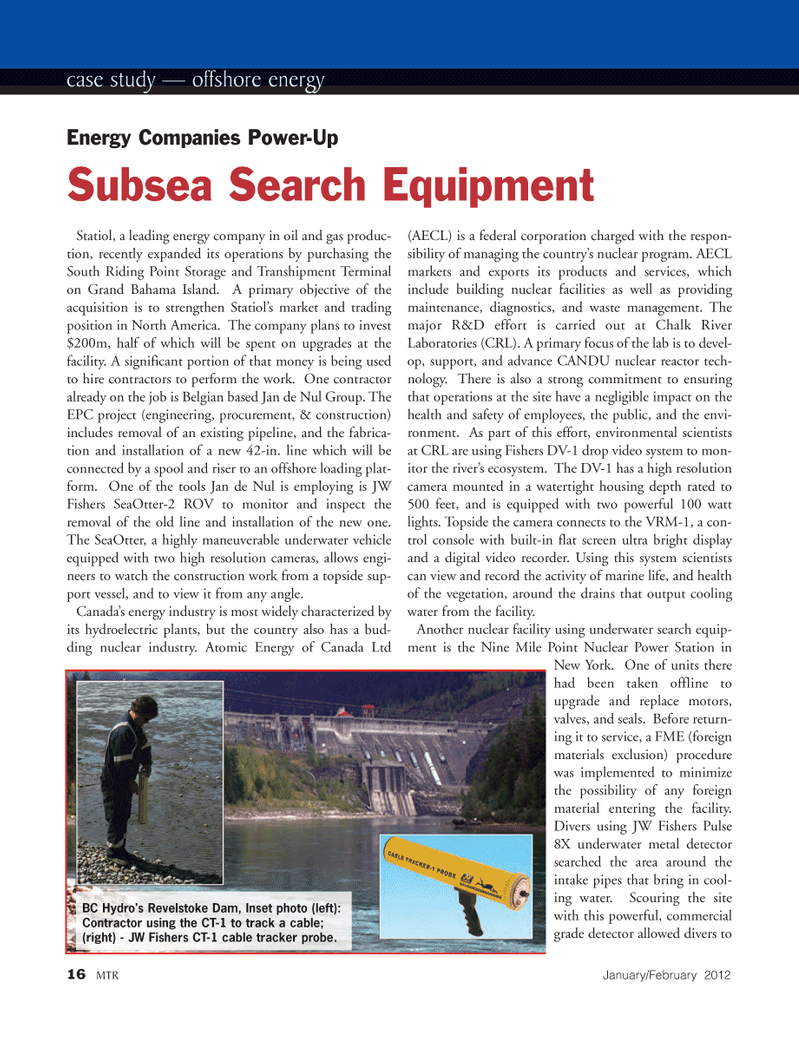
Page 16: of Marine Technology Magazine (January 2012)
Offshore Inspection, Repair & Maintenance
Read this page in Pdf, Flash or Html5 edition of January 2012 Marine Technology Magazine
case study ? offshore energy 16MTRJanuary/February 2012 Statiol, a leading energy company in oil and gas produc- tion, recently expanded its operations by purchasing the South Riding Point Storage and Transhipment Terminal on Grand Bahama Island. A primary objective of the acquisition is to strengthen Statiol?s market and trading position in North America. The company plans to invest $200m, half of which will be spent on upgrades at thefacility. A significant portion of that money is being used to hire contractors to perform the work. One contractor already on the job is Belgian based Jan de Nul Group. The EPC project (engineering, procurement, & construction) includes removal of an existing pipeline, and the fabrica- tion and installation of a new 42-in. line which will be connected by a spool and riser to an offshore loading plat- form. One of the tools Jan de Nul is employing is JW Fishers SeaOtter-2 ROV to monitor and inspect the removal of the old line and installation of the new one. The SeaOtter, a highly maneuverable underwater vehicle equipped with two high resolution cameras, allows engi- neers to watch the construction work from a topside sup- port vessel, and to view it from any angle. Canada?s energy industry is most widely characterized by its hydroelectric plants, but the country also has a bud- ding nuclear industry. Atomic Energy of Canada Ltd (AECL) is a federal corporation charged with the respon- sibility of managing the country?s nuclear program. AECL markets and exports its products and services, which include building nuclear facilities as well as providing maintenance, diagnostics, and waste management. The major R&D effort is carried out at Chalk River Laboratories (CRL). A primary focus of the lab is to devel- op, support, and advance CANDU nuclear reactor tech- nology. There is also a strong commitment to ensuring that operations at the site have a negligible impact on the health and safety of employees, the public, and the envi- ronment. As part of this effort, environmental scientists at CRL are using Fishers DV-1 drop video system to mon- itor the river?s ecosystem. The DV-1 has a high resolution camera mounted in a watertight housing depth rated to 500 feet, and is equipped with two powerful 100 watt lights. Topside the camera connects to the VRM-1, a con- trol console with built-in flat screen ultra bright display and a digital video recorder. Using this system scientists can view and record the activity of marine life, and health of the vegetation, around the drains that output cooling water from the facility. Another nuclear facility using underwater search equip- ment is the Nine Mile Point Nuclear Power Station in New York. One of units there had been taken offline toupgrade and replace motors, valves, and seals. Before return- ing it to service, a FME (foreign materials exclusion) procedure was implemented to minimize the possibility of any foreign material entering the facility. Divers using JW Fishers Pulse 8X underwater metal detector searched the area around the intake pipes that bring in cool-ing water. Scouring the site with this powerful, commercial grade detector allowed divers to Energy Companies Power-Up Subsea Search Equipment BC Hydro's Revelstoke Dam, Inset photo (left): Contractor using the CT-1 to track a cable; (right) - JW Fishers CT-1 cable tracker probe. MTR#1 (1-17):MTR Layouts 1/4/2012 2:34 PM Page 16

 15
15

 17
17
